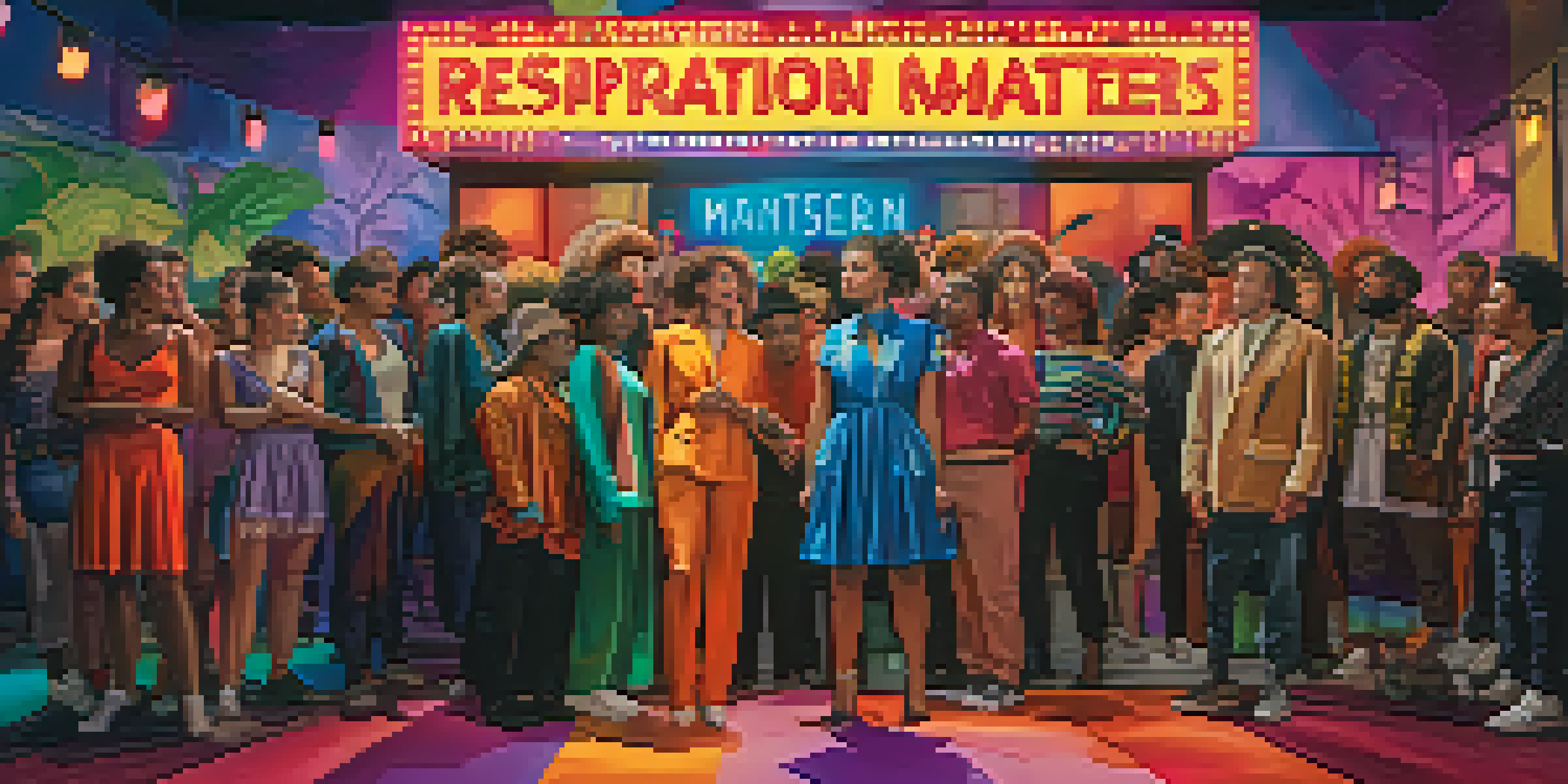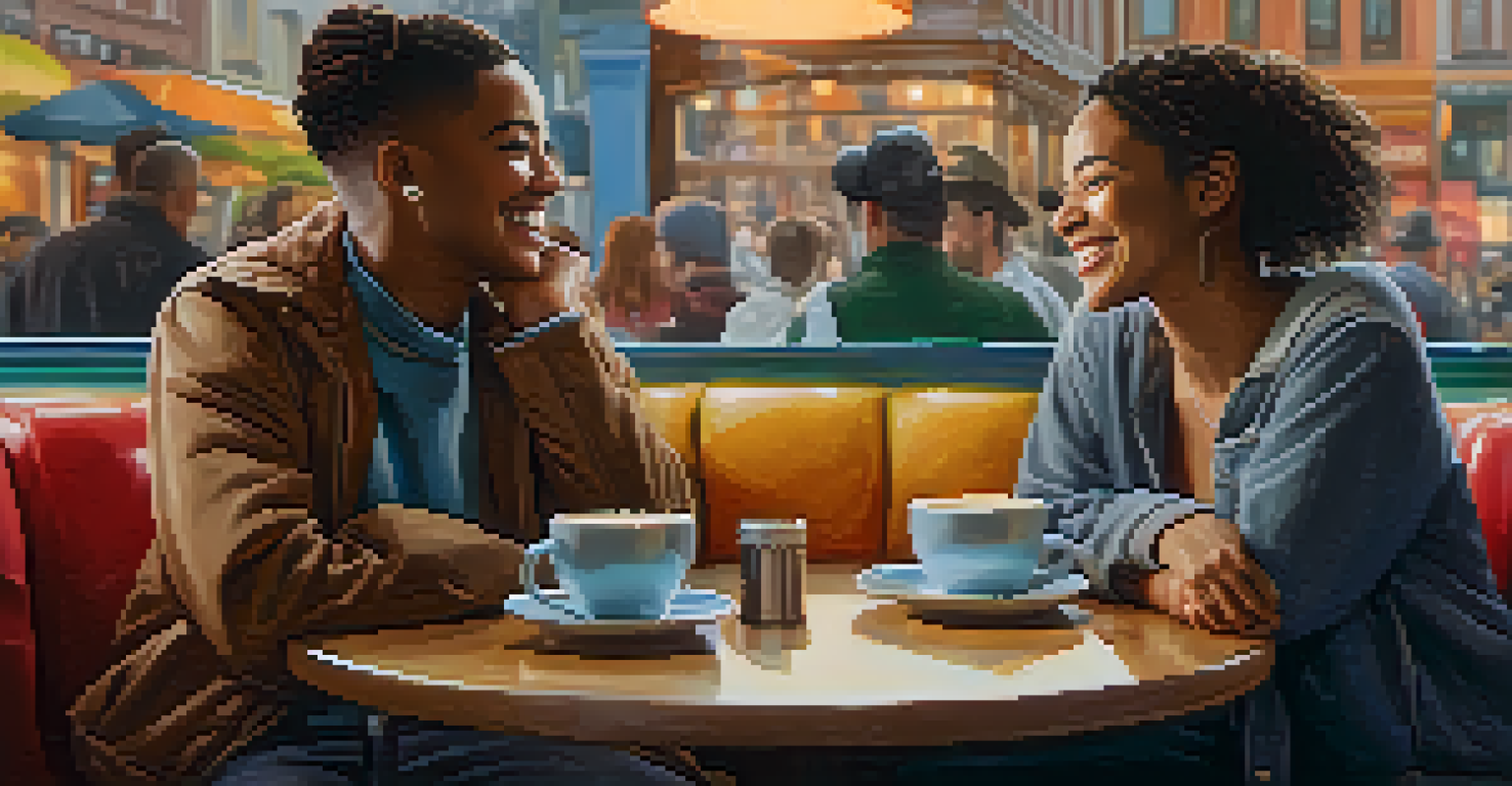The Role of LGBTQ+ Characters in Shaping Gender Norms in Films

Understanding Gender Norms and Their Evolution in Film
Gender norms are societal expectations about how individuals should behave based on their gender. In films, these norms often shape character development and plotlines, influencing audiences' perceptions of masculinity and femininity. Over the years, cinema has evolved to reflect changing attitudes towards gender, making space for more diverse representations.
Cinema can be a powerful tool in shaping our understanding of gender, helping to redefine norms and challenge stereotypes.
Traditionally, films have adhered to strict gender roles, presenting male characters as strong and assertive, while female characters were often depicted as nurturing and passive. However, as society began to embrace more fluid concepts of gender, filmmakers started to challenge these norms. This shift has opened the door for LGBTQ+ characters to play a pivotal role in redefining what it means to be masculine or feminine.
By showcasing a variety of gender identities and expressions, films can challenge stereotypes and encourage viewers to reconsider their own beliefs about gender. This evolution is crucial in creating a more inclusive environment where everyone can see themselves represented on screen.
The Rise of LGBTQ+ Representation in Cinema
In recent years, there has been a significant increase in LGBTQ+ representation in films. This shift reflects broader societal changes and the growing acceptance of diverse sexual orientations and gender identities. As these characters gain visibility, they not only entertain but also educate audiences about the complexities of gender and sexuality.

Movies like 'Moonlight' and 'Call Me by Your Name' have received critical acclaim for their authentic portrayals of LGBTQ+ relationships. These films not only tell unique stories but also challenge conventional notions of masculinity and femininity. By centering LGBTQ+ experiences, filmmakers encourage viewers to empathize with characters who might otherwise be marginalized.
Evolving Gender Norms in Film
Films are increasingly challenging traditional gender roles by showcasing diverse representations of masculinity and femininity.
This representation matters because it validates the experiences of LGBTQ+ individuals and fosters a sense of belonging. When audiences see characters who reflect their own struggles and triumphs, they are more likely to develop a deeper understanding of the spectrum of gender and sexuality.
LGBTQ+ Characters as Catalysts for Change
LGBTQ+ characters often serve as catalysts for change within film narratives. By breaking down traditional gender norms, they invite viewers to question their own preconceived notions about masculinity and femininity. For instance, characters like Billy from 'Billy Elliot' challenge societal expectations by pursuing ballet, a traditionally feminine activity, thus reshaping the conversation around gender roles.
Representation matters. It allows people to see themselves in stories and helps to foster empathy and understanding.
These characters can inspire audiences to embrace their authentic selves and reject societal pressure to conform. By portraying LGBTQ+ individuals as complex, multifaceted characters, filmmakers can highlight the similarities that transcend gender differences. This approach fosters empathy and understanding among viewers, encouraging them to embrace diversity.
Additionally, the inclusion of LGBTQ+ characters can create dialogue about gender fluidity and non-binary identities. When films incorporate these perspectives, they help demystify concepts that may be unfamiliar to some audiences, paving the way for broader acceptance.
The Impact of Stereotypes on LGBTQ+ Representation
While LGBTQ+ representation in film has improved, stereotypes still persist and can undermine the authenticity of characters. Common clichés can reduce complex individuals to mere caricatures, perpetuating harmful narratives about gender and sexuality. For example, the 'sassy gay friend' trope often diminishes the depth of LGBTQ+ characters, making them one-dimensional.
These stereotypes can negatively influence public perception and reinforce existing biases. When films fail to portray LGBTQ+ characters as fully realized individuals, they risk perpetuating misconceptions about gender and sexuality. This is why it's essential for filmmakers to approach representation with nuance and care.
Importance of LGBTQ+ Representation
Authentic portrayals of LGBTQ+ characters foster empathy and understanding, validating the experiences of marginalized individuals.
By moving beyond stereotypes, films can create a richer, more authentic portrayal of LGBTQ+ lives. This not only enhances the storytelling experience but also contributes to a more accurate understanding of the diverse spectrum of gender identities.
The Role of Filmmakers in Shaping Gender Norms
Filmmakers play a crucial role in shaping societal attitudes towards gender norms through the stories they choose to tell. By prioritizing authentic representation of LGBTQ+ characters, they can challenge traditional gender roles and encourage audiences to rethink their perspectives. Directors, writers, and producers have the power to create narratives that reflect the diversity of human experience.
When filmmakers embrace inclusivity, they set a precedent for future productions. This can lead to a more comprehensive understanding of gender dynamics within society, as audiences become more aware of the complexities surrounding gender identity and expression. Additionally, this shift can inspire young filmmakers to tell their own stories, further enriching the cinematic landscape.
Ultimately, the responsibility lies with filmmakers to create narratives that resonate with audiences and promote understanding. By showcasing a wide range of gender expressions, they can help dismantle rigid norms and foster a culture of acceptance.
Audience Reception and the Influence of LGBTQ+ Characters
The reception of films featuring LGBTQ+ characters has been overwhelmingly positive, with many viewers expressing appreciation for authentic representation. Audiences often resonate deeply with stories that reflect their own experiences, creating a sense of connection and community. This reaction underscores the importance of seeing diverse identities represented in mainstream media.
Moreover, films that feature LGBTQ+ characters can prompt discussions about gender norms and societal expectations. Viewers may find themselves questioning their own beliefs and biases, leading to greater awareness and acceptance of diversity. This kind of audience engagement is crucial for fostering a more inclusive society.
Filmmakers as Change Agents
Filmmakers have the power to shape societal attitudes by prioritizing inclusive narratives and breaking down rigid gender norms.
As LGBTQ+ representation continues to evolve in cinema, it remains essential for audiences to engage with these stories critically. By reflecting on their implications, viewers can contribute to the ongoing dialogue about gender norms and the importance of representation in media.
Looking Ahead: The Future of LGBTQ+ Characters in Film
As we look toward the future, the potential for LGBTQ+ characters in film appears promising. With increasing demand for diverse stories, filmmakers are becoming more aware of the importance of representation. This trend is likely to continue, paving the way for more nuanced portrayals of gender and sexuality.
Emerging filmmakers are also bringing fresh perspectives and stories to the forefront, further enriching the cinematic landscape. By sharing their unique experiences, they can challenge existing norms and introduce audiences to a broader understanding of gender identity. This new wave of storytelling has the potential to reshape societal attitudes for generations to come.

Ultimately, the ongoing evolution of LGBTQ+ representation in film is a testament to the power of storytelling. By embracing diversity, filmmakers can inspire change and create a more inclusive world where everyone can see themselves reflected on screen.